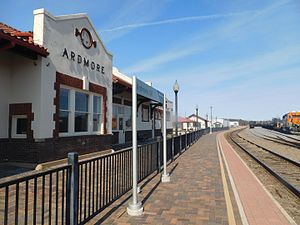Ardmore station (Oklahoma)
Ardmore, OK | ||||||||||||||||||||||||||||
|---|---|---|---|---|---|---|---|---|---|---|---|---|---|---|---|---|---|---|---|---|---|---|---|---|---|---|---|---|
 Ardmore station in February 2017 | ||||||||||||||||||||||||||||
| General information | ||||||||||||||||||||||||||||
| Location | 251 East Main Street Ardmore, Oklahoma United States | |||||||||||||||||||||||||||
| Coordinates | 34°10′20″N 97°07′32″W / 34.1721°N 97.1255°W | |||||||||||||||||||||||||||
| Owned by | City of Ardmore | |||||||||||||||||||||||||||
| Line(s) | BNSF Railway Red Rock Subdivision | |||||||||||||||||||||||||||
| Platforms | 1 side platform | |||||||||||||||||||||||||||
| Tracks | 2 | |||||||||||||||||||||||||||
| Construction | ||||||||||||||||||||||||||||
| Accessible | Yes | |||||||||||||||||||||||||||
| Other information | ||||||||||||||||||||||||||||
| Station code | Amtrak code: ADM | |||||||||||||||||||||||||||
| History | ||||||||||||||||||||||||||||
| Opened | 1909 | |||||||||||||||||||||||||||
| Rebuilt | November 16, 1915–August 7, 1917[1][2] | |||||||||||||||||||||||||||
| Key dates | ||||||||||||||||||||||||||||
| September 27, 1915 | Depot destroyed in explosion[3] | |||||||||||||||||||||||||||
| Passengers | ||||||||||||||||||||||||||||
| FY 2023 | 5,831[4] (Amtrak) | |||||||||||||||||||||||||||
| Services | ||||||||||||||||||||||||||||
| ||||||||||||||||||||||||||||
| ||||||||||||||||||||||||||||
| ||||||||||||||||||||||||||||
Ardmore (Amtrak: ADM) is an Amtrak train station in Ardmore, Oklahoma. The station is serviced by the daily Heartland Flyer, which travels from Oklahoma City, Oklahoma to Fort Worth, Texas.
The station house is owned by the Ardmore Main Street Authority, which restored the station in 2015. The station currently serves as an event venue. A public park, called Depot Park, was opened on the west side of the station in 2022.[5]
History
[edit]Original building
[edit]The first train station in Ardmore was built in 1909 by the Atchison, Topeka and Santa Fe Railway (or simply "Santa Fe").
On September 27, 1915, the building was destroyed in an explosion caused by a natural gas leak, which in turn set off dynamite in nearby freight sheds. The station was totally destroyed, and much of the town was set on fire, resulting in 43 deaths.[3][6]
A train filled with aid workers, dubbed the "Mercy Train", was sent from Gainesville, Texas in the aftermath of the explosion. Locomotive 1108, which led the Mercy Train, was obtained by the city after it exited service in 1954; it is currently on display in Depot Park.[6]
Current building
[edit]Construction of a replacement depot began shortly after the explosion, with railcars serving as a temporary replacement.[2] The rebuilt station was completed in 1917 as a joint effort between the Santa Fe and Rock Island Railroad.[6] A small building for the Railway Express Agency was built just north of the station.
In 1979, Amtrak discontinued its Lone Star service, ending passenger service to the city, though freight service remained.
In 1998, Burlington Northern and Santa Fe Railway, the successor to the original Santa Fe, sold the station and surrounding land, including the REA building, to the city's Main Street Authority for $20,001. BNSF retained ownership of the track and platform, and it continues to operate from the REA building.[6]
On June 15, 1999, Amtrak's Heartland Flyer debuted, returning the station to service.
References
[edit]- ^ "New Ardmore Station". Muskogee Times-Democrat. November 16, 1915. p. 10. Retrieved December 27, 2021 – via Newspapers.com.

- ^ a b "New Union Station Opened This Afternoon". The Daily Ardmoreite. August 7, 1917. p. 5. Retrieved December 27, 2021 – via Newspapers.com.

- ^ a b United Press International (September 30, 1915). "Ardmore Explosion Claims Many Lives". The Choctaw Herald. Hugo, Oklahoma. p. 2. Retrieved December 27, 2021 – via Newspapers.com.

- ^ "Amtrak Fact Sheet, Fiscal Year 2023: State of Oklahoma" (PDF). Amtrak. March 2024. Retrieved June 30, 2024.
- ^ "Event Venues". Ardmore Main Street Authority. Retrieved 2023-10-27.
- ^ a b c d "Ardmore, OK (ADM)". The Great American Stations. Amtrak. Retrieved 2023-10-27.
External links
[edit]![]() Media related to Ardmore station (Oklahoma) at Wikimedia Commons
Media related to Ardmore station (Oklahoma) at Wikimedia Commons
- Ardmore, OK – Amtrak
- Ardmore, OK – Station history at Great American Stations (Amtrak)
- Texas Eagle page Archived 2006-11-19 at the Wayback Machine
- Ardmore Main Street Authority
- Ardmore, OK - Train Web
- Ardmore, OK - Santa Fe Surviving Depots
- Amtrak stations in Oklahoma
- Former Atchison, Topeka and Santa Fe Railway stations
- Railway stations in the United States opened in 1909
- Ardmore, Oklahoma
- Transportation in Carter County, Oklahoma
- Buildings and structures in Carter County, Oklahoma
- Southern United States railway station stubs
- Oklahoma building and structure stubs

